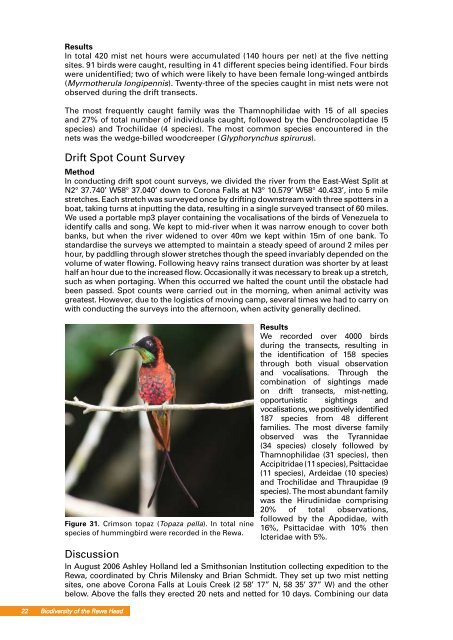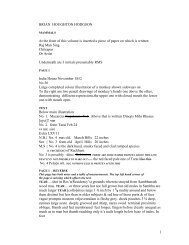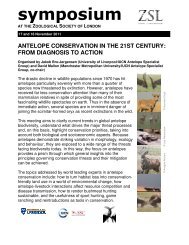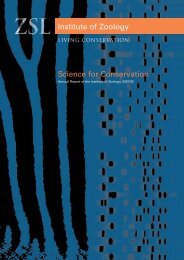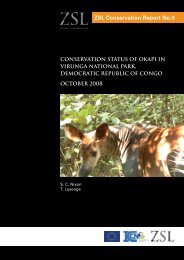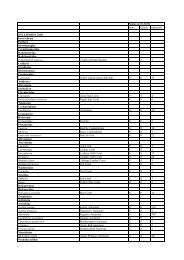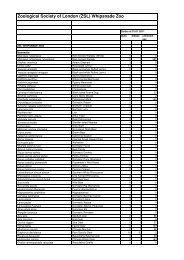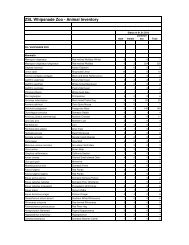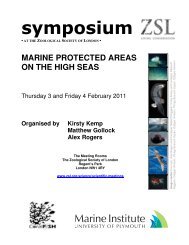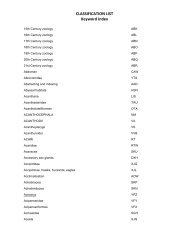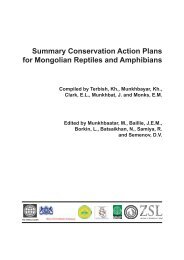Biodiversity of the Rewa Head B Zoological Society of London ...
Biodiversity of the Rewa Head B Zoological Society of London ...
Biodiversity of the Rewa Head B Zoological Society of London ...
Create successful ePaper yourself
Turn your PDF publications into a flip-book with our unique Google optimized e-Paper software.
Results<br />
In total 420 mist net hours were accumulated (140 hours per net) at <strong>the</strong> five netting<br />
sites. 91 birds were caught, resulting in 41 different species being identified. Four birds<br />
were unidentified; two <strong>of</strong> which were likely to have been female long-winged antbirds<br />
(Myrmo<strong>the</strong>rula longipennis). Twenty-three <strong>of</strong> <strong>the</strong> species caught in mist nets were not<br />
observed during <strong>the</strong> drift transects.<br />
The most frequently caught family was <strong>the</strong> Thamnophilidae with 15 <strong>of</strong> all species<br />
and 27% <strong>of</strong> total number <strong>of</strong> individuals caught, followed by <strong>the</strong> Dendrocolaptidae (5<br />
species) and Trochilidae (4 species). The most common species encountered in <strong>the</strong><br />
nets was <strong>the</strong> wedge-billed woodcreeper (Glyphorynchus spirurus).<br />
Drift Spot Count Survey<br />
Method<br />
In conducting drift spot count surveys, we divided <strong>the</strong> river from <strong>the</strong> East-West Split at<br />
N2° 37.740’ W58° 37.040’ down to Corona Falls at N3° 10.579’ W58° 40.433’, into 5 mile<br />
stretches. Each stretch was surveyed once by drifting downstream with three spotters in a<br />
boat, taking turns at inputting <strong>the</strong> data, resulting in a single surveyed transect <strong>of</strong> 60 miles.<br />
We used a portable mp3 player containing <strong>the</strong> vocalisations <strong>of</strong> <strong>the</strong> birds <strong>of</strong> Venezuela to<br />
identify calls and song. We kept to mid-river when it was narrow enough to cover both<br />
banks, but when <strong>the</strong> river widened to over 40m we kept within 15m <strong>of</strong> one bank. To<br />
standardise <strong>the</strong> surveys we attempted to maintain a steady speed <strong>of</strong> around 2 miles per<br />
hour, by paddling through slower stretches though <strong>the</strong> speed invariably depended on <strong>the</strong><br />
volume <strong>of</strong> water flowing. Following heavy rains transect duration was shorter by at least<br />
half an hour due to <strong>the</strong> increased flow. Occasionally it was necessary to break up a stretch,<br />
such as when portaging. When this occurred we halted <strong>the</strong> count until <strong>the</strong> obstacle had<br />
been passed. Spot counts were carried out in <strong>the</strong> morning, when animal activity was<br />
greatest. However, due to <strong>the</strong> logistics <strong>of</strong> moving camp, several times we had to carry on<br />
with conducting <strong>the</strong> surveys into <strong>the</strong> afternoon, when activity generally declined.<br />
Figure 31. Crimson topaz (Topaza pella). In total nine<br />
species <strong>of</strong> hummingbird were recorded in <strong>the</strong> <strong>Rewa</strong>.<br />
22 <strong>Biodiversity</strong> <strong>of</strong> <strong>the</strong> <strong>Rewa</strong> <strong>Head</strong><br />
Results<br />
We recorded over 4000 birds<br />
during <strong>the</strong> transects, resulting in<br />
<strong>the</strong> identification <strong>of</strong> 158 species<br />
through both visual observation<br />
and vocalisations. Through <strong>the</strong><br />
combination <strong>of</strong> sightings made<br />
on drift transects, mist-netting,<br />
opportunistic sightings and<br />
vocalisations, we positively identified<br />
187 species from 48 different<br />
families. The most diverse family<br />
observed was <strong>the</strong> Tyrannidae<br />
(34 species) closely followed by<br />
Thamnophilidae (31 species), <strong>the</strong>n<br />
Accipitridae (11 species), Psittacidae<br />
(11 species), Ardeidae (10 species)<br />
and Trochilidae and Thraupidae (9<br />
species). The most abundant family<br />
was <strong>the</strong> Hirudinidae comprising<br />
20% <strong>of</strong> total observations,<br />
followed by <strong>the</strong> Apodidae, with<br />
16%, Psittacidae with 10% <strong>the</strong>n<br />
Icteridae with 5%.<br />
Discussion<br />
In August 2006 Ashley Holland led a Smithsonian Institution collecting expedition to <strong>the</strong><br />
<strong>Rewa</strong>, coordinated by Chris Milensky and Brian Schmidt. They set up two mist netting<br />
sites, one above Corona Falls at Louis Creek (2 58’ 17” N, 58 35’ 37” W) and <strong>the</strong> o<strong>the</strong>r<br />
below. Above <strong>the</strong> falls <strong>the</strong>y erected 20 nets and netted for 10 days. Combining our data


